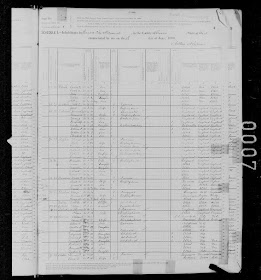Pages
▼
Saturday, August 27, 2016
Researching Beyond Census Records
It is so simple and reassuring to find someone in a U.S. Census record. Between 1850 and 1940, it is almost a given that anyone in the U.S. can be found with a minimum of effort. Oh, you say, until you can't find them. Well, I found my Great-Uncle Allen Benedict Tanner and his family in the 1880 U.S. Federal Census by the simple expediency of reading through every page of the Census record in the small community of Beaver, Beaver, Utah. By the way, there are only 36 pages in that particular enumeration district, so it only took a few minutes to find the family.
The problem is that when you can't find your family in the U.S. Census where do you go? What do you do? What if you also strike out with searches on FamilySearch.org and Ancestry.com? I should mention that when I tried to search on FamilySearch.org after I found the record by looking at every page, I did a search for "Allen B Tanner" in Beaver, Beaver, Utah and the search engine failed to find him or his family. So had I not already found him through the page by page search, I might have come to the conclusion that "he wasn't in the 1880 U.S. Census." This points out another important rule: always search the original records when they are available.
In short, doing genealogical research is a lot more than census searches and finding a family in the U.S. Census is sometimes a lot more than a census search also. Did I mention that I found my Grandfather in the 1920 U.S. Census when he was indexed as "Tamer" rather than "Tanner?"
The suggestion here is that there are lots of records about your ancestors other than just those in the U.S. Census. For example, Allen Benedict Tanner has twenty sources attached and I know that the number is only a fraction of the total number of places this particular Tanner family is mentioned in records. Just looking down the list already in the FamilySearch.org Family Tree, I could add in about three times that many sources if I had the time and inclination. But you say, so what? Who cares? And what difference does it make if there is one source or fifty?
Genealogical research is not a numbers game. We are not out to set some kind of record for adding sources to a family. There are no extra points for each source added. So why not stop with the one U.S. Census record or so that establishes the family and leave it at that?
By the way, this is a serious question and one that is posed to me regularly. I am regularly asked "How many sources is enough to add to someone in the Family Tree." My answer is always the same, "All of them." Just yesterday, I was getting frustrated with not being able to find a certain family in either FamilySearch.org or Ancestry.com. I did a general Google search and found an extensive biography of the father of the family with a long list of sources.
Is there a specific place to go if you cannot find an individual ancestor or family in the U.S. Census? Not really. The general rule is begin your search with marriage records as they are the most reliably recorded type of record. I eventually found yesterday's difficult family in cemetery records. I might also point out that you aren't through searching until you have looked at every type of record listed in the FamilySearch.org Research Wiki and the FamilySearch.org Catalog. I mean every single type of record listed. But usually, you can focus on church records or civil records to find most families.
When things get tough, the tough get going.


For one family I was researching I took the time to read through a census that hadn't been indexed and I found a baby that was just a few months old. For some reason his christening wasn't in the parish records, so if I hadn't taken the time to look at every census I wouldn't have found him. In another case I took the time to find all the census records and I found the oldest child, who had already moved away from home before the other censuses had been taken.
ReplyDelete